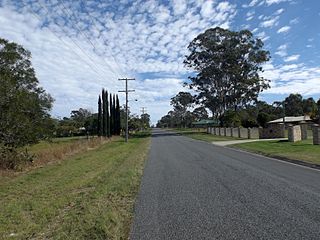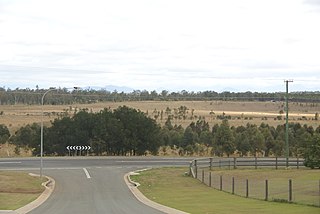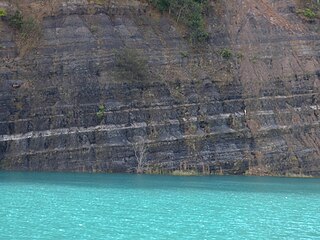Related Research Articles
The Surat Basin is a geological basin in eastern Australia. It is part of the Great Artesian Basin drainage basin of Australia. The Surat Basin extends across an area of 270,000 square kilometres and the southern third of the basin occupies a large part of northern New South Wales, the remainder is in Queensland. It comprises Jurassic through to Cretaceous aged sediments derived from Triassic and Permian arc rocks of the Hunter-Bowen orogeny. Towns situated above the basin, once dominated by agriculture, are experiencing a boom as mines and infrastructure in the area are expanded.

Rhoetosaurus, named after Rhoetus, a titan in Greek mythology, is a genus of sauropod dinosaur from the Jurassic (Oxfordian) Walloon Coal Measures of what is now eastern Australia. Rhoetosaurus is estimated to have been about 15 metres (49 ft) long, weighing about 9 tonnes. Subsequent authors have sometimes misspelled the name: Rhaetosaurus ; Rheteosaurus.

William Brian Keith Holmes is an Australian palaeobotanist, best known for his work "Fructifications of Glossopteris" (1974), published in the Proceedings of the Linnean Society of New South Wales. Despite having received no formal training in palaeontology, he has become an important contributor in the field and has described some 80 new species, mostly from 2 quarries at Nymboida in northern New South Wales, and situated on the Triassic.

Thagoona is a mixed-use locality in the City of Ipswich, Queensland, Australia. In the 2021 census, Thagoona had a population of 1,077 people.

Walloon is a town and rural residential locality in the City of Ipswich, Queensland, Australia. In the 2021 census, the locality of Walloon had a population of 2,305 people.

Haigslea is a locality split between the City of Ipswich and the Somerset Region in South East Queensland, Australia. In the 2021 census, Haigslea had a population of 507 people.

Willowbank is a rural locality in the City of Ipswich, Queensland, Australia. In the 2021 census, Willowbank had a population of 1,351 people.
Jeebropilly is a rural locality in the City of Ipswich, Queensland, Australia. In the 2021 census, Jeebropilly had "no people or a very low population".
The Shire of Moreton was a local government area in South East Queensland, Australia, located about 50 kilometres (31 mi) southwest of Queensland's capital, Brisbane. It represented an area surrounding but not including Ipswich, and existed from 1917 until 1995, when it merged into the City of Ipswich, City of Brisbane, and Shire of Esk.
Austropelor is an extinct genus of possible chigutisaurid temnospondyl from the Early Jurassic of Australia. Fossil remains were found in the Marburg Sandstone Formation.
The Walloon Coal Measures are a Late Jurassic geologic subgroup in Queensland, Australia. Deposited within the Surat Basin, it is considered Oxfordian to early Tithonian in age based on lead-uranium dating of tuffites within the unit.

The Clarence Moreton Basin is a Mesozoic sedimentary basin on the easternmost part of the Australian continent. It is located in the far north east of the state of New South Wales around Lismore and Grafton and in the south east corner of Queensland. It is the part of the Great Artesian Basin that extends to the east coast in Australia's central eastern lowlands.

In lithostratigraphy, coal measures are coal-bearing strata, with the term typically applied to European units of the Upper Carboniferous System.
The Denmark Hill Insect Bed is a Triassic fossil locality in the Denmark Hill Conservation Park of Ipswich, Queensland, Australia.

The Shire of Mutdapilly is a former local government area in the south-east of Queensland, Australia. The name comes from the Mutdapilly locality, but the locality was never the administrative centre of the shire.

Mount Walker is a rural locality in the Scenic Rim Region, Queensland, Australia. In the 2021 census, Mount Walker had a population of 129 people.

Mount Forbes is a rural locality split between the City of Ipswich and the Scenic Rim Region, Queensland, Australia. In the 2021 census, Mount Forbes had a population of 262 people.

Mutdapilly is a rural locality in south-east Queensland, Australia. It is split between the local government areas of Scenic Rim Region and City of Ipswich. In the 2021 census, Mutdapilly had a population of 308 people.

Lower Mount Walker is a locality split between the Scenic Rim Region and City of Ipswich local government areas of South East Queensland, Australia. In the 2021 census, Lower Mount Walker had a population of 192 people.
References
- ↑ "Fossilworks: Gateway to the Paleobiology Database". fossilworks.org. Retrieved 17 December 2021.
- ↑ "Mutdapilly fossil locality". Mindat. Retrieved 24 March 2024.
- ↑ Mcloughlin, Stephen; Drinnan, Andrew (March 1995). "A Middle Jurassic flora from the Walloon Coal Measures, Mutdapilly, Queensland, Australia". Memoirs of the Queensland Museum. 38 (1): 257–272.
27°47′00″S152°40′01″E / 27.7833°S 152.667°E